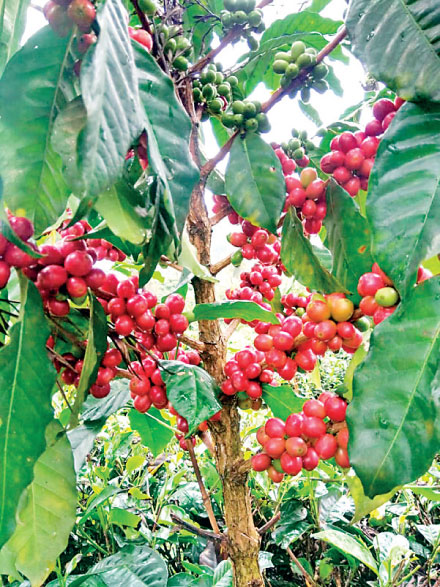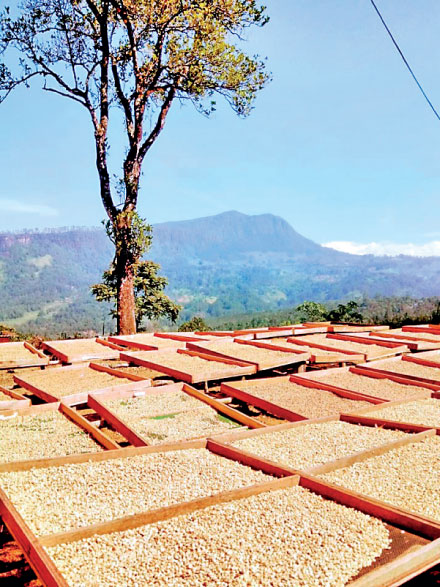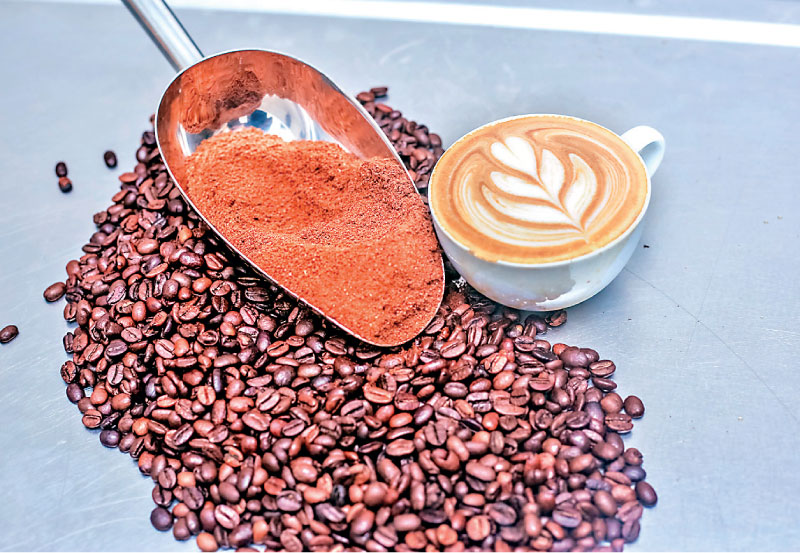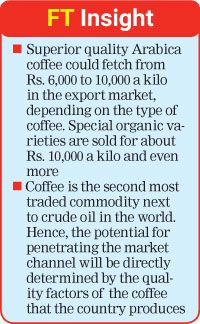Thursday Apr 24, 2025
Thursday Apr 24, 2025
Thursday, 18 May 2023 02:55 - - {{hitsCtrl.values.hits}}

Sri Lanka's 'Bitter Berry' now among top ten in the world

Coffee beans being sun-dried in lustrous Kothmale valley

Brewing a perfect cup of Lankan coffee
 With our very own coffee variety – Lak Parakum introduced and promoted by the Department of Export Agriculture (DEA) being recognised as one of the top ten Arabica varieties of coffee in the global market, there is renewed hope for Sri Lankan coffee. The increasing franchise costs that entail imported coffees are also driving many popular coffee houses in Colombo and the suburbs to turn to local blends, some of them which have already tapped a lucrative export market. The coffee rust which ended the island’s coffee romance in the British-occupied then Ceylon is given hope for resurgence today
With our very own coffee variety – Lak Parakum introduced and promoted by the Department of Export Agriculture (DEA) being recognised as one of the top ten Arabica varieties of coffee in the global market, there is renewed hope for Sri Lankan coffee. The increasing franchise costs that entail imported coffees are also driving many popular coffee houses in Colombo and the suburbs to turn to local blends, some of them which have already tapped a lucrative export market. The coffee rust which ended the island’s coffee romance in the British-occupied then Ceylon is given hope for resurgence today
By Randima Attygalle
With our very own coffee variety – Lak Parakum introduced and promoted by the Department of Export Agriculture (DEA) being recognised as one of the top ten Arabica varieties of coffee in the global market, there is renewed hope for Sri Lankan coffee. The increasing franchise costs that entail imported coffees are also driving many popular coffee houses in Colombo and the suburbs to turn to local blends, some of them which have already tapped a lucrative export market. The coffee rust which ended the island’s coffee romance in the British-occupied then Ceylon is given hope for resurgence today.
The local coffee production and extent have increased over the years. Sri Lanka’s coffee cultivation covers 4,787 ha. today, according to DEA’s statistics. The production which was at 2,439 mt. in 2021, has increased to 2,537 mt. by the end of 2022.
The two main commercially important species of coffee locally grown are Arabica (Coffea arabica) and Robusta (Coffea canephora). These two main species grown here include several varieties. While Arabica coffee varieties are recommended for mid and up country areas with an altitude of over 400m (Nuwara Eliya, Kandy, Matale and Badulla), Robusta variety is recommended for mid and low country with an altitude of less than 600m (Kegalle, Kurunegala, Kandy and Matale). These recommendations are made depending on the temperature variation. While Arabica prefers a temperature of 15-28ºC, Robusta thrives in a temperature of 18-36ºC.
Coffee is one of the most widely consumed beverages in the world. The Coffee Market Report of April this year issued by the International Coffee Organization (ICO) notes that the world coffee consumption increased by 4.2% to 175.6 million bags in the year 2021/22. It is expected to increase by 1.7% to 178.5 million bags in coffee year 2022/23
Lak Parakum among top 10
More than 80% the world demand is for Arabica coffee says DEA’s Additional Director General (Research) Dr. Ananda Subasinghe. Lak Parakum with its quality parameters, in terms of the yield, disease-tolerance and the texture of beans, stands among the best ten Arabica varieties in the world, he adds. Each kilo of Lak Parakum seed, according to DEA, could produce 2,000 to 3,000 plants and a sizeable amount of plants have been distributed among growers already.
Expanding exports
The export market for Sri Lankan coffee too expanded over the years. From 30.47 mt. in 2021, our coffee exports have increased to 50.56 mt. in 2022. Australia, UAE, USA, Maldives, New Zealand, Chile, UK and Germany are the major buyers of Sri Lankan coffee. Several new measures are now in place to tap a lucrative market for Sri Lankan coffee. Production of planting material with private sector nurseries, awareness programs for crop management, harvesting and processing practices for high quality products, promoting value addition, introduction of GAP (Good Agricultural Practices), certification to get premium prices and increasing the coffee extent to 5,800 ha and the export volume to 200 mt. by 2025 are among these.
The current average productivity of coffee is about 450-500kg per ha. However, this could easily double within a year with Productivity Improvement Programs (PIP) for existing cultivations, points out Dr. Subasinghe.
Although threats from rust diseases are still prevalent in coffee fields, they can be controlled with good management practices and available control measures, points out the DEA authorities. Apart from the rust disease, the major pest problem which threatens coffee is the berry borer damage. This too can be managed with good crop management practices, assures the DEA. Even though DEA has given a fertiliser recommendation for coffee, most of the farmers are not applying them due to different reasons such as, shortage of fertiliser, higher prices and their preference for only organic fertiliser and mulching practices, etc. If they can apply half the recommendation and Gliricidia mulch, it is more beneficial for a sustainable crop, Dr. Subasinghe points out. Conservation of the soil moisture up to six months after flowering is also crucial as the most important yield determining-practice for increasing the quantity of the coffee yield, he says.
The better price offered for Lak Parakum variety in the local market is another boost to revive coffee growing, says DEA’s Deputy Director (Research) Thushari Liyanage. “Due to the low prices offered for coffee, which was about Rs. 400 per kilo of beans, five years ago, many growers were discouraged and neglected coffee in the last few years, however, currently a kilo of quality coffee could fetch an average about Rs. 1,200 to 1,300 per kilo.”
Enhancing productivity
Immature coffee harvesting and bad processing practices lead to rejection of some of the local coffee beans by importing countries, points out Liyanage who goes on to note that if timely harvesting and good processing practices can be followed by growers and processors, the export potential for local coffee could be strengthened. Today only about 20-30% of local coffee meets international criteria for exports.
Applauding the contribution made by the private sector, Liyanage encourages ‘Certification’ among coffee growers and exporters. “Unlike in the tea industry, certification processes are still not very popular in the local industry. However, if certification can be promoted, the recognition and the price offered for our coffee in the international market could be a lot more,” maintains the DEA official who also notes that coffee productivity needs to double along with good irrigation practices for the local coffee industry to be more competitive. She also cites the potential for new job opportunities within the coffee industry such as roasters, coffee baristas and coffee tasters with the expansion of it.
Coffee romance
History has it that coffee was introduced to us in 1503 by the Arab traders from Yemen. However, the planting of coffee as a commercial crop in the island commenced with the Dutch occupation and continued under British rule. Planter R.B. Butler, who had experience in coffee plantations in Jamaica, came here in 1837 and introduced methods to yield a better coffee crop. By 1863, the value of coffee imported into Europe from all parts of the world amounted to £ 270 million, and we were exporting nearly a third of that.
The colonial ‘Ceylon’ was among the top coffee producing and exporting nations and a coffee-drinking culture complete with kopi kaday (coffee kiosks) and kopi kele (coffee forests) evolved. Christine Spittel-Wilson’s famous book The Bitter Berry revolves around the ethos of a Ceylonese coffee plantation.
Sadly, the coffee rust of 1870 (caused by the fungus Hemileia vastatrix) destroyed all plantations bringing the coffee romance of the country to an end. Although rust-tolerant varieties were later introduced, today coffee is an intercrop with tea and coconut. However, the DEA encourages coffee growers to expand their coffee acreage as monocrop cultivations as well.
Reskilling skills
Tharanga Rajith Muramudali who has been in the coffee industry since 2012 promotes his own produce under the ‘Helanta’ brand today and is a leading exporter of premier Sri Lankan coffee. He exports premier Arabica coffee of ‘shade planting’, ‘organic planting’ and ‘mixed planting’ to Japan, Australia and Thailand. Sourcing coffee from his own lands in Kothmale, Tharanga also runs Natural Coffee Café in Kandy. He is also a supplier of premier local coffee to some of the leading hotel chains in the country. Tharanga, who says that high quality Sri Lankan coffee supply cannot meet the demand, calls for fellow growers to expand their coffee coverage. “Superior quality Arabica coffee could fetch from Rs. 6,000 to 10,000 a kilo in the export market, depending on the type of coffee. Special organic varieties are sold for about Rs. 10,000 a kilo and even more,” says the self-made coffee entrepreneur.
Tharanga’s coffee has clinched several awards at international coffee festivals, scoring over 80 points which is a mark of eligibility to be among top coffee brands anywhere in the world, he says. “Although we have enough land, we still do not have sufficient coffee nurseries,” lamented Tharanga whose own nurseries hope to expand to distribute 500,000 plants next year.
Nalin Priyantha of Kiyota Coffee fame produces eight signature tastes of coffee in his factory sourced from his own lands in Matale. A leading exporter of premium Sri Lankan coffee to Japan, Nalin points out that if the producers and exporters could enhance the quality of their produce, a larger export market could be tapped for local coffee. Comparing our Arabica coffee to a ‘mound of gold covered in mud’, Nalin also calls for increased empowerment of small holders. “Our soil conditions, water quality of high elevations all contribute to producing some of world’s best coffee and if growers could enhance their GAPs sky is the limit for our crop,” remarks Nalin, whose Amberlyplace Coffee Academy strives to add more muscle to the industry by opening several career paths as coffee roasters and baristas.
 If timely harvesting and good processing practices can be followed by growers and processors, the export potential for local coffee could be strengthened. Today only about 20-30% of local coffee meets international criteria for exports
If timely harvesting and good processing practices can be followed by growers and processors, the export potential for local coffee could be strengthened. Today only about 20-30% of local coffee meets international criteria for exports
Expanding coverage
Since 2016, Elpitiya Plantations PLC (EPP) has been cultivating new tolerant-varieties of coffee in their poor tea-yielding lands in the up and mid-country (which were predominantly coffee estates back in time) as an intercrop. EPP’s coffee extent of 103.05 ha. is to be increased to 283.36 ha. within the next five years, says EPP’s General Manager, Up Country Cluster, L.M.C.P. Liyadipita. The coffee expansion exercise of EPP also envisages to train over 200 employees in planting, harvesting, processing and value addition for export markets.
Developments in all aspects of the Sri Lankan coffee market, including production, processing, marketing, and consumption, have been significant, points out the EPP’s senior official. “There is a steady increase in demand for specialty Arabica and fine Robusta coffee both in local and export markets especially in countries like Australia. New Zealand, Japan. UAE and Canada. The MDF (Market Development Facility) along with SL Coffee Association and the Department of Export Agriculture are jointly working with upgrading and sharing giving knowledge and rendering assistance to develop the coffee industry in the country to meet international standards.”
Braving climate change
Sri Lankan coffee with its unique quality, flavour and aroma, has a great potential for reaching an international niche market with proper branding, says Liyadipita. “The country’s highlands provide an ideal environment for cultivating high-quality Arabica beans, resulting in unique and flavourful profiles that set them apart from other coffee varieties. Additionally, Sri Lankan coffee is predominantly produced by smallholder and backyard farmers who employ organic and sustainable farming practices, ensuring the preservation of the environment’s biodiversity.”
Higher temperatures, changes in rainfall patterns, increased pest and disease outbreaks, and loss of biodiversity and ecosystem services are some of the adverse effects that coffee cultivation faces due to climate change, says EPP official. “At EPP, we have implemented GAPs to counteract the negative effects of climate change and ensure a productive coffee harvest. We harvest over 259 million litres of rainwater in harvesting ponds to recharge the soil to mitigate the drought effect and incorporate soil with 61% organic compost. We have identified 166 ha. of stream reservation for restoration by planting native plants/bamboo. Development of catchment and connecting animal corridors with increasing green cover to preserve the micro climatic conditions is another initiative.”
EPP has also introduced several schemes to encourage small coffee holders both within the plantation company and outside in the neighbouring villages. Investing in R&D, enhancing the capacity and skills of coffee farmers and processors, enhancing the awareness and appreciation of Sri Lankan coffee, strengthening collaboration and coordination among multiple stakeholders in the coffee sector and supporting a conducive policy and regulatory environment are among the measures mooted by Liyadipita to take Sri Lankan coffee to the next level.
Sri Lankan coffee to the next level
Upcountry estates of the Kahawatte Plantations, expanded over the Nawalapitiya area of Kothmale Valley and the Dolosbage hills, produce high-quality, single-origin coffees for the world market, sourced from 21 ha. The company plans to expand the coffee coverage to 50 ha. by 2027. The estates, as Kahawatte Plantations PLC Director Plantations, Chaminda Gunarathna points out, have the ideal climatic conditions for coffee-growing in the country. “Our elevation varies from 600 msl to 1,650 msl, which provides the most favourable elevation for Arabica coffee cultivation. Moreover, the soil factor in the Nawalapitiya area has improved with GAPs such as adding compost, planting green manure crops and adopting soil conservation methods, as coffee’s performance is better on nutrient-rich soils.”
As a diversification strategy, Kahawatte Plantations commenced coffee cultivation in 2021 under the guidance of the DEA. “As our existing coffee fields will be in the bearing stage in 2025, we have planned to commence a coffee processing centre by 2025 to produce high-quality value-added coffees required by the international market,” says its Director Plantations.
Coffee is the second most traded commodity next to crude oil in the world. Hence, the potential for penetrating the market channel will be directly determined by the quality factors of the coffee that the country produces, says Gunarathna. “Although there is a good demand for Sri Lankan Arabica coffee in the global market, the price fluctuation has negatively affected the coffee farmers.”
To mitigate the impact of climate change, their plantations have adopted GAPs and climate resilience measures introduced by Dilmah Conservation such as mulching, shade management, proper irrigation, rain-water harvesting and maintenance of good ground cover, says Gunarathna. “As a climate resilience measure, we cultivate and maintain our coffee as agroforestry models where we have a greater impact, especially in the case of pest and disease outbreaks. Further, we maintain our coffee fields with zero herbicide to ensure the proper biological properties in the soil.”
In a bid to assist smallholders of coffee, Kahawatte Plantations offer plants sourced by their nurseries and technical assistance. Enabling more mechanisation of field practices of coffee cultivation is critical if Sri Lankan coffee is to reach the next level, remarks Gunarathna. Expanding technical assistance from the government to expand large-scale cultivation and enhancing the specialty knowledge of coffee processing are also mooted by the senior official as necessary tools if Sri Lankan coffee is to compete in the international coffee market. “At Kahawatte Plantations, we strive at all times to raise the bar for Sri Lankan coffee in the same way we did with our tea, earning a name as a leading brand in the international market,” Gunarathna notes.
 Sri Lankan coffee with its unique quality, flavour and aroma, has a great potential for reaching international niche market with proper branding
Sri Lankan coffee with its unique quality, flavour and aroma, has a great potential for reaching international niche market with proper branding
 A voice for the industry
A voice for the industry
As part of Lanka Coffee Association’s (LCA) efforts in elevating the Sri Lankan coffee industry and enabling a platform to voice the industry’s concerns to the Government, LCA in collaboration with the DEA and Market Development Facility, hosted the ‘Coordination for Improvement of the Coffee Industry in Sri Lanka’ program in Kandy last year to lend voice to the key concerns in the industry. In a bid to showcase Sri Lanka’s specialty coffee, local baristas’ coffee brewing skills and promote the emerging coffee culture, LCA is also to support Sri Lanka Coffee Festival and Barista Championship which will kick off in mid-May this year.
“As part of LCA’s mandate, we are also working at the grass root level to improve the quality and quantity of coffee produced in Sri Lanka. In addition, we are hosting events such as the coffee festival to promote and showcase our coffee to the world. Through such strategic initiatives, we are able to attract a stronger international market for Sri Lanka. In addition, moves to obtain Geographical Indication (GI) for Sri Lankan coffee are also under consideration,” says LCA Chairman and Founder and CEO of Soul Coffee Company, Rinosh Nasar.
Soul Coffee, as its founder explains, is sustainably grown by over a 1,000 farming families across the luscious highland forests of Sri Lanka. “Since its inception in 2014, the brand has been at the forefront in the revival of Sri Lankan coffee and tirelessly pushing to improve the coffee experience, and the quality of local coffee available to the everyday coffee drinker. We work closely with our hardworking and extremely skilled local farmers to grow our premium quality coffee, without using any environmentally devastating mono-culture practices, and following ethical farming standards. Our ethically conscious approach to present our customers with the perfect cup of coffee that they can enjoy without any reservation, is something we strongly believe in and reflects in our core values,” remarks Nasar.
Pic credit: Helanta Coffee and Kiyota Coffee
Discover Kapruka, the leading online shopping platform in Sri Lanka, where you can conveniently send Gifts and Flowers to your loved ones for any event including Valentine ’s Day. Explore a wide range of popular Shopping Categories on Kapruka, including Toys, Groceries, Electronics, Birthday Cakes, Fruits, Chocolates, Flower Bouquets, Clothing, Watches, Lingerie, Gift Sets and Jewellery. Also if you’re interested in selling with Kapruka, Partner Central by Kapruka is the best solution to start with. Moreover, through Kapruka Global Shop, you can also enjoy the convenience of purchasing products from renowned platforms like Amazon and eBay and have them delivered to Sri Lanka.
Discover Kapruka, the leading online shopping platform in Sri Lanka, where you can conveniently send Gifts and Flowers to your loved ones for any event including Valentine ’s Day. Explore a wide range of popular Shopping Categories on Kapruka, including Toys, Groceries, Electronics, Birthday Cakes, Fruits, Chocolates, Flower Bouquets, Clothing, Watches, Lingerie, Gift Sets and Jewellery. Also if you’re interested in selling with Kapruka, Partner Central by Kapruka is the best solution to start with. Moreover, through Kapruka Global Shop, you can also enjoy the convenience of purchasing products from renowned platforms like Amazon and eBay and have them delivered to Sri Lanka.